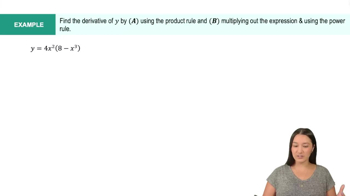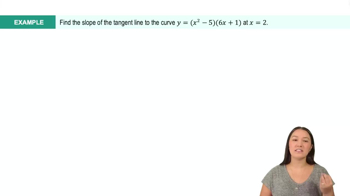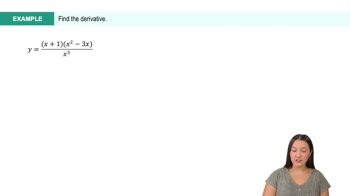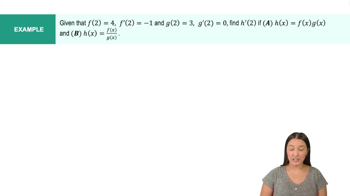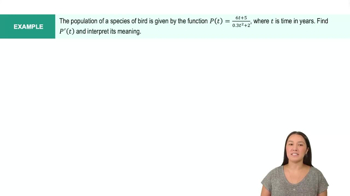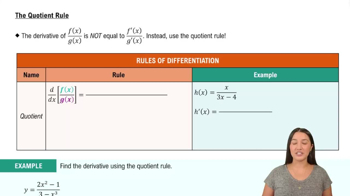Table of contents
- 0. Functions7h 52m
- Introduction to Functions16m
- Piecewise Functions10m
- Properties of Functions9m
- Common Functions1h 8m
- Transformations5m
- Combining Functions27m
- Exponent rules32m
- Exponential Functions28m
- Logarithmic Functions24m
- Properties of Logarithms34m
- Exponential & Logarithmic Equations35m
- Introduction to Trigonometric Functions38m
- Graphs of Trigonometric Functions44m
- Trigonometric Identities47m
- Inverse Trigonometric Functions48m
- 1. Limits and Continuity2h 2m
- 2. Intro to Derivatives1h 33m
- 3. Techniques of Differentiation3h 18m
- 4. Applications of Derivatives2h 38m
- 5. Graphical Applications of Derivatives6h 2m
- 6. Derivatives of Inverse, Exponential, & Logarithmic Functions2h 37m
- 7. Antiderivatives & Indefinite Integrals1h 26m
- 8. Definite Integrals4h 44m
- 9. Graphical Applications of Integrals2h 27m
- 10. Physics Applications of Integrals 2h 22m
3. Techniques of Differentiation
Product and Quotient Rules
Problem 3.57b
Textbook Question
Suppose that functions ƒ(x) and g(x) and their first derivatives have the following values at x = 0 and x = 1.
x ƒ(x) g(x) ƒ'(x) g'(x)
0 1 1 -3 1/2
1 3 5 1/2 -4
Find the first derivatives of the following combinations at the given value of x.
b. ƒ(x)g²(x), x = 0
 Verified step by step guidance
Verified step by step guidance1
To find the derivative of the function ƒ(x)g²(x) at x = 0, we need to apply the product rule and the chain rule. The product rule states that the derivative of a product of two functions u(x) and v(x) is given by u'(x)v(x) + u(x)v'(x).
In this case, let u(x) = ƒ(x) and v(x) = g²(x). We need to find the derivative of v(x) using the chain rule. The chain rule states that the derivative of a composite function h(g(x)) is h'(g(x))g'(x).
Since v(x) = g²(x), we can express it as h(g(x)) where h(x) = x². The derivative h'(x) is 2x, so the derivative of v(x) = g²(x) is 2g(x)g'(x).
Now, apply the product rule: the derivative of ƒ(x)g²(x) is ƒ'(x)g²(x) + ƒ(x)(2g(x)g'(x)).
Substitute the given values at x = 0: ƒ'(0) = -3, g(0) = 1, g'(0) = 1/2, and ƒ(0) = 1. Calculate ƒ'(0)g²(0) + ƒ(0)(2g(0)g'(0)) using these values.
 Verified video answer for a similar problem:
Verified video answer for a similar problem:This video solution was recommended by our tutors as helpful for the problem above
Video duration:
3mPlay a video:
Was this helpful?
Key Concepts
Here are the essential concepts you must grasp in order to answer the question correctly.
Product Rule
The Product Rule is a fundamental principle in calculus used to differentiate products of two functions. It states that if you have two functions, ƒ(x) and g(x), the derivative of their product is given by ƒ'(x)g(x) + ƒ(x)g'(x). This rule is essential for finding the derivative of combinations of functions, such as ƒ(x)g²(x), as it allows us to apply the differentiation process systematically.
Recommended video:
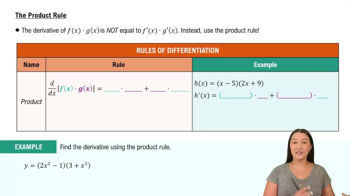
The Product Rule
Chain Rule
The Chain Rule is another critical differentiation technique used when dealing with composite functions. It states that if a function y is composed of another function u, then the derivative of y with respect to x is the derivative of y with respect to u multiplied by the derivative of u with respect to x. In the context of g²(x), the Chain Rule helps us differentiate the square of the function g(x) effectively.
Recommended video:

Intro to the Chain Rule
Evaluating Derivatives at Specific Points
Evaluating derivatives at specific points involves substituting the given x-value into the derivative expression to find the slope of the function at that point. In this problem, we need to compute the derivatives of ƒ(x)g²(x) at x = 0, which requires using the values of ƒ(0), g(0), ƒ'(0), and g'(0) provided in the table. This step is crucial for obtaining the final numerical result.
Recommended video:

Critical Points
Related Videos
Related Practice



